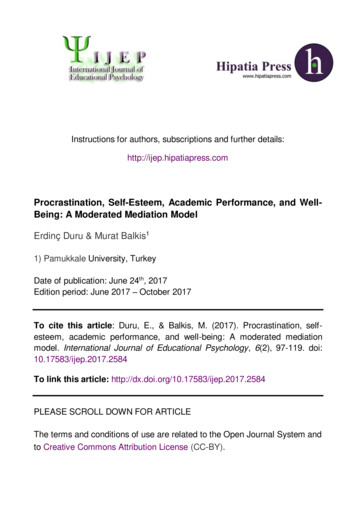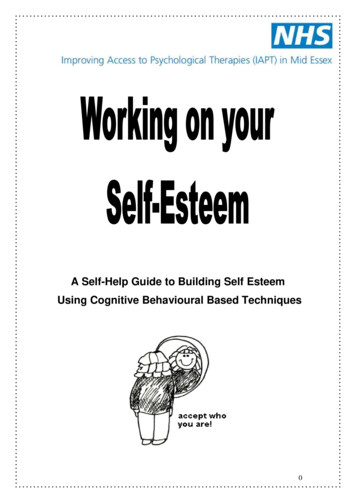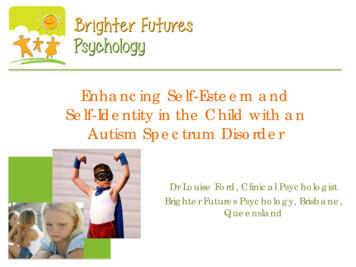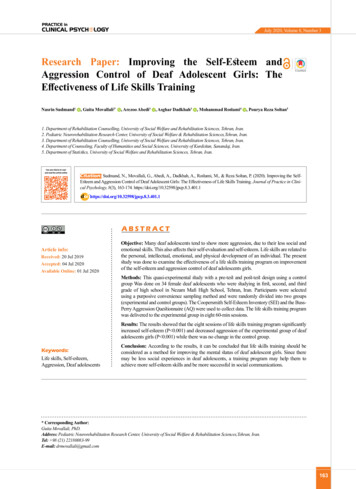
Transcription
The relationship between self-esteem andacademic performance of freshman at theUniversity of the Virgin IslandsBYEno IniamaA Research Paper presented at the annual conference of the CaribbeanStudies Association, Marriott Hotel, St. Kitts, June 2004.
ABSTRACTThis study examined the relationship between self-esteem-and academicperformance of freshman students at the University of the Virgin Islands, St.Thomas campus in 2004. The researcher used clustered sampling to acquire thesample from the total population. The sample consisted of 48 individuals, 10 malesand 38 females. The literature on this topic states that having a high self-esteem doesnot necessarily produce higher academic performance. The researcher used anexisting self-esteem inventory named the SEI (Self-Esteem Index) to derive a rawscore and a percentile rank for each participant. The statistical tests used are thechi-square test of independence and the two-factor Analysis of Variance. Theresults of the research design employed and the chi-squared test show that there isno significant relationship between high school grade point average and self- esteemindex score. The results of the hvo-factor Analysis of Variance show that the type ofhigh school attended and gender of participant make no significant impact oncollege grade point average or on Scholastic Aptitude Test composite score. There isno significant interaction effect. More research needs to be done on this topic.
The researcher wanted to use youth in St. Croix, USVI who have already been introuble as my population of interest. This was original idea for a research study, but dueto time limitations the researcher decided to use a more feasible and accessiblepopnlation. The limitation is that the researcher would have to get permission in order tothin St. Croix the previous semestex. This is how the researchergo to the y o facilitydecided on the relationship between self-esteem and academic performance as my topic.Many individuals do not realize that there is a difference bet-kveen self-concept andself-esteem. They feel that the two concepts are used interchangeably in speech. This isnot true. There is a big difference between self-esteem and self-concept. Self-concept ishow a person sees thein self, which can change on a daily basis. Self-esteem is how aperson sees them self, and rates their overall value as a person, or worthiness as a humanbeing. The concept of self-esteem is not able to be seen or measured with the naked eye,so it is necessary for a self-esteem inventory to be used to measure self-esteem.Self-esteem is ones attitude towards oneself which may be positive, neutral, ornegative." (Oxford dictionary of Psychology) Self-esteem is static and does not changemuch. It is not possible for a person to have a positive self-esteem, one day and the nextto have a negative self-esteemThe first research hypothesis states that there is a significant relationship betweenself-esteem and academic performance among freshman students at the University of theVirgin Islands. The second research hypothesis states that there is a significant differencebetureen the means of the two groups based on gender1 type of high school attended.Why is education valued in some cultures? I was born in Ibadan, Nigeria and there isa large university there called the University of Ibadan. Education is valued highly in
Nigeria as well as in the United States and many other First World, post-industrializednations because education is a means to achieve success and make lots of money, whichis important for capitalistic societies. In the United States during the era of slavery, themain method for trying to keep the slaves on a lower status, was to deny them theprivilege of getting an education, instead they were forced to remain illiterate. The fewslaves that could read or write were the one that could write passes for themselves andother slaves, and these were also people who were in the position to lead rebellions.Now, education is just as important because you will receive a higher salary as youreducation or training increases. This is a type of mental, institutionalized, slavery anddoes still keep African-Americans in a lower social class or position in comparison toWhites. This brings me to the point of why this topic is so important? It is important forall students to perform to the best of their ability academically. This research project hasthe intent of examining the relationship between self-esteem and academic performance.STATEMENT OF THE PROBLEMIt is worthwhile that this study was conducted so tha:.we can see how important it isfor elementary, junior high, high school students, as wt-ll ascollege students to buildupon their self-esteem so that children here in the United States Virgin Islands canachieve more academically. It has been shown that high academic performanceinfluences a person's self-esteem, but it is still questionable whether the reverse is t n e .The researcher expected to find a strong positive correlation between self-esteem andacademic performance. That is, as self-esteem increases, so does academic performance.Also the reverse should hold true, that as academic performance increases so will selfesteem.
LITERATURE REVIEWThere is literat lreboth supporting and refuting the theory that there is a relationshipbetween self-esteem and academic performance. There is much research and literatureabout self-esteem in the United States, Australia, and St. Croix, but I have not found anyresearch that has been attempted on the island of St. Thomas. In the Virgin Islands, Dr.t y the Virgin Islands hasFrank Mills of The Eastern Caribbean Center at the U i v e r s ofdone a study 011 juvenile offenders and factors that inci casfrthelikelihood of a juvenile inbecoming a repeat offender. This study shows that a first time offender who feelsworthless is twice as likely to become a repeat offender as a first time offender who doesnot feel worthless. A person who feels worthless is suffering from a low or negative selfesteem. From this study, one can see the impact of a negative self-esteem on our society."Burke, Hunt & Bickford (1985) found that college students with high self-esteemexpect good results on academic examinations. They also tend to attribute satisfactoryresults to stable features within themselves. When students with low-self-esteem scorelow on examinations they tend to regard the score as a 1-efi3ctionon their ability ratherthan for some other less personal reason." (Nolan, 1996)In the Virgin Islands, most children come from single-parent households, a majorityare headed by females, mothers or grandmothers. If the mother has feelings of low selfworth herself, these feelings of low self-worth possibly could be passed onto her children.If the mother does not feel worthy herself, she will spend less time trying to ensure thather children feel worthy as individuals. In a research done on the island of St. Croix, itwas found that family structure does play a role in self-esteem in junior high schoolstudents, but that family structure impacts the self-esteem of males over females.
"Historically, America's colleges and universities have had an educational and socialmission to educate in a sense that extends beyond the cognitive and intellectualdevelopment of students. That broader mission has defined education to includeincreased self-understanding; expansion of persona; intellectual, cultural, and sociall orizonsand interests; liberation from dogma, prejudice, and narrow-mindedness;development of personal moral and ethical standards; preparation for useful andproductive employment and membership in a democratic society; and the generalenhancement of the quality of graduates' post college lives." (Pascarella, 1991)When researching self-esteem, students generalized judgments of their own worth."An individual with high self-esteem is typically characterized as having feelings ofworth, being able to do things as well as others, having a number of good qualities,having much to be proud of, having a positive attitude toward oneself, feeling useful toothers, feeling self-confident, and being satisfied with oneself. (Pascarella, 1991)Most of the research on self-esteem has been done on children and a very smallpercentage has been done on young adults.A study at the University of Michigan shows that the relation between GPA and esteemdepends on the population of interest, the context in which the relationship is examinedand the time of measurement.There is also research that shows that improved academic performance in childrenincreases their self-esteem, aIthough increased self-esteem does not improve academicperfornlance. Hence, efforts to improve self-esteem in children are misplaced and shouldbe replaced by efforts at improving academic performance. (Moeller, 1994) Theresearcher find this to be very interesting because it is stating that the bottom line is that
improving academic performance in children is more important than improving selfesteem in children. This is true, because the researcher feels that she had a very highfeelings of self-esteem because she was performing excellently in elementary and injunior high school.There is a study of African American students that wasdone at a historically blackcollese that shows the correlation between strong racial identity and high academicis overstated. The researchers found that a high level of self-esteem, ratherthan racial identity, was a major factor in determining academic success. (Lockett, 2003)This illeans that racial identity does not play a major role in determining academicperfonnance and achievement.There are sociological theorists that address the issue of self-concept. Charles HortonCooley and George Herbert Mead are the two sociologists that talk about the self and theimportance of self-concept. Charles Horton Cooley (1864-1929) developed a theorycalled the "looking-glass self'. Cooley believes that there is a three-step process for thedevelopment of the self to occur. First, we must imagine our own appearance. Second,we must interpret the reaction of others. The third and final stage is that ones selfconcept must be developed based on both how one sees themselves as well as how oneinterprets and perceives that others see them. This is important because self-conceptprecedes self-esteemThere was a study done by Bray, which examined the influence of academicachievement on a college student's self-esteem. The purpose of the study was toascertain whether academic achievement had more of an impact on a college student'sself-esteem depending on whether the student was a general student or an Honors student.
The researcher used the Rosenberg Self-Esteem Inventory. The results of this study werethat academic achievement and self-esteem have a positive relationship, which agreeswith previous research. This means that as academic achievement increases, self-esteemwill also increase.SIGNIFICANCE OF THE STUDYThis study is important because it will show how important it is for youth in theVirgin Islands to have a positive self-esteem in order to become more productive citizens.Right now, there is a shortage of educated persons in the Virgin Islands. Most politiciansin the Virgin Islands do not even possess a bachelor's degree, to even think about amasters or doctoral degree. Our young people are leaving to go to college in the UnitedStates and lilost of them choose not to return to the Virgin Islands for whatever reason.With the loss of accreditation, education is becoming more of an issue. Education is theway to lead the people of the Virgin Islands away from social problems such as crime,poverty, racism and racial prejudice, teenage pregnancy, drugs, both dealing and using,HIV/AIDS, divorce, child abuse, and sexual abuse that is now running rampant. Allthese social problems occur when there are low levels of self-esteem and can make aperson's self-esteem negative regardless of how many positive role models there are in achild's life.This study is significant to the Virgin Islands community so that there may be achange in the education system where all Virgin Islands youth will have an improvedself-esteem due to academic performance, and despite living in poverty or living inunstable family environments.This study is of significance to the Social Sciences because self-esteem is evident in
social psycl ology,but it also has influence in history, political science, sociology,cultural geography, social work and economics because every human being has thepotential for having a high self-esteem or low self-esteem.METHODOLOGYThis study took place in the spring semester of the year 2004. The research design forthis study is survey research. The instrument that was .tilizedwas a questionnaire. Theresearcher used an existing self-esteem inventory. The c s e cusedh e r clustered samplingso that the study may have external validity, which means that it will be able togeneralize to the population. The researcher acquired a list of all the freshman coursesand selected five classes to use as part of the sample. The researcher got permission fromall the professors before administering the questionnaires. The researcher had to ask eachstudent to verify that each student who participated was a freshman to make sure thatonly freshman students were included in the sample. The researcher attempted to include10% of this total population into my sample. The population studied in this researchstudy is college freshmen at the University of the Virgin-Ist:mds, St. Thomas campus.The sample size for this study is 48 participants, 10 males and 38 females.The questionnaire that the researcher used consisted of eighty-seven questions, whichis a longer questionnaire than most. This questionnaire is included in the Appendix ofthis research paper. Most of the questions on the questionnaire are on an interval level ofmeasurenlent using Likert scale , which are on an interval scale to find out level ofagreement with each statement. The researcher used the categories: strongly agree,agree, disagree, or strongly disagree. The researcher asked demographic questions, suchas age, gender, race, type of high school attended, whether public or private, which are
nolninal variables. The researcher asked students to provide their high school gradepoint average, college grade point average and Scholastic Aptitude Test (SAT) compositescore as a measure of academic performance.The researcher used the chi-squared as well as Analysis of Variance (ANOVA) toanalyze the data. The researcher used the chi-squared test hascertain whether there is arelationsl1ip between high school grade point average and self-esteem ranking score. Theresearcher used a two-factor Analysis of Variance to ascertain whether or not there is arelationship between the factors, gender (malelfemale) and type of school (publiclprivate)on Scholastic Aptitude Test composite score and college grade point average.The assumptions of using chi-squared are that both variables have to be on a nominallevel of measurement. No assumptions were made about the shape of the distribution.There is one assumption that this research did not meet. This is the assumption that notmore than twenty percent of the categories should have expected frequencies of less than:!ve.In a factorial ANOVA, there is more than one indepe ldentvariable. In this researchproject, there are two independent variables (gender/schoal) each with two levels(malelfemale, publiclprivate). The two independent variables must remain independentof each other. A 2*2 factorial ANOVA is very useful because it allows the researcher toascertain the effects of the two independent variables on the dependent variable, plus itshows tvhether there is an interaction effect. The anticipated limitation to this study is thefact that the sample only includes freshman students that are on the St. Thomas campusand this means that the study may not be able to be generalized to the larger freshmanpop llationat the University of the Virgin Islands.
RESULTSIn this section descriptive statistics, cross tabs, comparison of the means, andANOVA results are given. ANOVA does compare the means of the two variables, butthe researcher achieved slightly different results from just a comparison of the means.The following are frequencies for age, gender, race, school, and high school grade pointaverage.AGE-15-1718-2021-2324 & 0Sixty two percent of the participants (30) were between the ages of fifteen and 20,while only thirty-seven and a half percent of the participants (1 8) were aged twenty-oneand 0.879.2100.0Approximately seventy-nine percent (38) of the participants were female, whileapproximately twenty-one percent (1 0) were males. This means that there were threetimes more female participants than male .0
Eighty-three percent of the participants were Black (40). Only six percent wereHispanic (3), four percent were Caucasian (2). Two percent each were East Indian (I),didn't answer the question (I), or stated that they were of the human race (1).SCHOOLpublicprivateTotalValid .312.5100.0CumulativePercent4.287.5100.0Approxin atelyeighty-three percent of the participants (40) attended public school,while only approxi natelythirteen percent (6) attended private school. Two participants(4.6%) did not respond to this ncy61.8 - 2.52.51 3.23.21 -4.0Total41.7Six participants did not respond to this question (12.5%). Five participants (10.4%) ofthe participants stated that they had a cumulative high szhool g a d e point averagebetween the ranges of 1.8-2.5. Seventeen participants (35.4%) stated that they had acumulative high school grade point average between the ranges of 2.51-3.2. Twentyparticipants (41.7%) stated that they had a cumulative high school grade point average ofbetween 3.21 -4.00. Approximately 77% of all the participants stated that they had a highschool grade point average of 2.5 1 or more.
Table 1.IDescriptive Statistics for college grade point average, SAT score, and raw score.Descriptive 002.00350188.00Maximum4.001280303.00MeanStd. The mean college grade point average for the twenty participants is 3.15 15 with astandard deviation of .54379. The mean SAT score for rhe 21 participants was 837. Themeall raw score from the self-esteem inventory was 244. The minimum college gradepoint average was 2.00 while the maximum college grade point average was 4.00. Therange for college grade point average is two whole grade points. The minimum SATscore was 350, while the maximum SAT score was 1280. The range for SAT scores is930. The minimum raw score for the self-esteem inventory was 188, while the maximumwas 330.Table 2.1Mean SAT score based on gender.GENDERStd. 29The mean SAT score for the male participants w,as 774.-Themean SAT score for thefeinale participants was 857. The mean SAT score for the total sample was 837. Thismeans that the male participants mean was lower SAT score than the mean SAT score forall the participants as well as the mean SAT score for the female participants.Table 2.2 Mean college grade point average based on gender.GENDERStd. 79The mean college grade point average for the male participants was 3.40. The mean
college grade point average for the female participants was 3.05. The mean college gradepoint average for the illale participants was 3.15. This means that females have a lowercollege grade point average than the male participants.Table 2.3 Mean college grade point average based oni high school attended.SCHOOLpublicprivateTotalStd. Deviation3.12353.31003.151520,54379The mean college grade point average for the (1 7) I 1.1rticipants that attended a publichigh school was 3.12. The mean college grade point average for the (3) participants thatattended a private high school was 3.3 1. The mean high school grade point average forIthe (20) participants who answered this question was 3.15.Table 2.4 Mean SAT score based on high school l980.00837.6221Std. Di;Ti243.329The mean SAT score for the (16) public school participants was 828. The mean SATscore for the (4) public school participants was 840. Orre participant had a SAT score of980, but they did not indicate what type of high school thzy attended.Chi-squared Table 3.1 Is there a significant relationship between high school gradespoint average and percentile ranklself-esteem index rate?Chi-Squared ResultsP-valueHGPA &I.254SignificanceNot significantPercentile RankHGPA & SelfEsteem IndexII97---Not significant225INone of the chi-square results were signi cant at a p-value .05. A chi square test that
is not significant indicates that there is no significant between the two variables. Therewas no significant relationship between high school grade point average and percentiIerank of the self-esteem index. There was no significant relationship between high schoolgrade point average and self-esteem index score.Table 4.1 Does gender or school impact the college grade point average ofparticipants'?2*2 Factor Analysis of VarianceDV: CGPAGENDERSum ofDegrees ofSquaresFreedom.0831P-ValueSignificancep .O5.612Not significantp .05SCHOOL.0141334Not significantpB.05GENDER*.I111Not significantSCHOOLNone of the ANOVA results were significant at a p-value .05.The dependentvariable was the college grade point average of the participants. Gender did notsignificantly impact the college grade point average of the participants. The type of highschool attended did not have a significant impact on the college grade point average.Finally, the interaction between gender and type of high school attended did notsignificantly impact the college grade point average.
Table 4.2 Does gender or school significantly impact the SAT score of theparticipants'!2*2 Factor Analysis of VarianceDV: SATGENDERSum ofDegrees ot significant11 o significanttp .05SCHOOL1122198.65GENDER*Not significant.I841IItINone of the ANOVA results were significant at a p-value .05. The dependent variablewas the SAT composite score of the participants. Gender did not significantly impact theSAT conlposite score of the participants. The type of high school attended did not have asignificant impact on the SAT colnposite score. Finally, the interaction between genderand type of high school attended did not have an impact on the SAT composite score.Even though, gender, type of high school did not have an significant effect, it is stillinteresting to look at the differences.Chi-Squared Table 1.8 Comparison of high school grade point average and self-esteem ratingSEI1.8 - 2.52.51 3.23.21 -4.0No 4216016248Even t h o u hthe statistical tests showed that there is no significant relationship between
self-esteem and acadenlic performance this crosstab shows that twelve students out oftwenty students who stated that their high school grade point average was between 3.2 1and 4.00 had an above average or high score on the self-esteem inventory. In contrast,only one of the five students that stated that their high school grade point average wasbetween 1.8 and 2.5 had an above average self-esteem scare.Tllhles 6.1 through Tuble 6.6 ure colnpnrison of the means tising ANOVA.Table 6.1 Comparison of the mean SAT score based on gender (ANOVA)7Gender753.333(a)943.846female---The mean SAT score for the male participants was 753, while the mean SAT score forfenlales was 943, which is almost 200 points greater than the mean score for the maleparticipants.Table 6.2 Comparison of the mean SAT score based on type of high school attended 839.103The mean SAT score for the participants who attended a pubkc high school was 839. Themean SAT score for the participants who attended a private high school was 840. Thismeans that the means for type of high school attended are almost the same for thedepenclent variable, which is the SAT score. There is a smaller standard error for p tblicscllool participants, because there were more students that attended a public high schoolincluded in the sample.
Table 6.3 Comparison of the mean SAT score based on gender1 type of high school rivate-980.000821.5381 o3o.000The mean SAT score for the male participants who atte lded a public high school is856.The meail SAT score for the female participants who attended a public high school is821. The mean SAT score for the male participants who attended a private high school is850. The meal1 SAT score for the female participants who attended a private high schoolis 1030. The female participants that attended a private high school had by far thehighest mean SAT score.Table 6.4 Comparison of the mean grade point average based on gender ANOVA)GENDERmaleMEANfemale3.3733.177The mean college grade point average for the male par\xip,mts was 3.373, while themean college grade point average for the female participa tswas 3.177, which is slightlower than the males' college grade point average. Please, bear in mind that thesefi-eshman st tdentshave only received grades for one semester at the University of theVirgin Islands.Table 6.5Comparison of the mean college grade point average based on type of high schoolattended IANOVA)SCHOOLpublicprivate3.2353.31 5
The meaii college grade point average for participants who attended a private high schoolwas 3.3 15. The itlean college grade point average for participants who attended a publichigh school was 3.235. This means that the participants who attended a private highschool had a slightly higher mean college grade point average than the participants whoattended a public high school.Table 6.6 Comparison of the mean college grade point a v e r a s b a z e don gender and type of highschool attended te3.44513.30013.330The illean college grade point average for males who attended a public high school was3.445 while the mean college grade point average for males who attended a private highschool was 3.330. The mean college grade point average for females who attended apublic high school was 3.025. The mean college grade point average for females whoattended a private high school was 3.330.LIMITATIONS OF THE STUDYThei-e are linlitations to this study and the researcher would like to suggest ways thatthis study may be improved. A detrimental factor to this study was the lack of time andmoney, which are two valuable resources. The sample size may not have been as large asnecessary. This may be due to the fact that most of the students were unwilling to becomeparticipants because they were looking at the length of the survey. A couple of studentsjol ingly stated, "This is just like the Daily News."The researcher realized that many of the respondents in the sample did not writedown a Scholastic Aptitude Test score. The researcher made this question an openended question, but should have used ranges such as 0-40(1,401-800, 801- 1200, 1201-
1600, to elicit a better response fro111 the respondents. The participants were unwilling or lnableto give a high school or college grade point average. The researcher realized thisd u r i n data analysis.It w o alsol d have been better if the researcher could have used a sequential design,meaning that this study would be both cross-sectionalijswell as longitudinal. It would benice i f could have followed the same participants and gav? them the same self-esteeminventory to see how their answers would change each ycar over a four or five yearperiod. This would entail that the researcher would have to know each participant'sname, and this might violate confidentiality issues.There were also strengths in the study. The major strength of the study is that thestudy used an existing self-esteem inventory. The researcher did not allow the length ofthe questionnaire to deter her. She realized the length of the self-esteem inventory wouldlnalte more work for her, but she planned her time and used what little time she hadwisely and efficiently.
BIBLIOGRAPHYBetl ili ister,Eurrice UVI strrlk proll rcesprofiles of K I . yot thsliicel?, to cor lnlitcrimes.Tlle Dtrill, Nelvs, (Novenzher-29, 2003)Beresfortl, Regrlcr ( 1992) Tire relatiorlship of the firrnilv structtrre to the self-esteem of,jurrio 111gl1sc/1ooI stzr leirts012 St. Cr-0i.y (thesis)B LI!',B. hi.,(2000) Tile Ii flrrenceof Acnclen1ic Achievenzent on n College Studeirt 's SelfEstee n.Bzrrlce. J P . , Hrlrrl, J.P., &Bicyord, R.L., (1985). Cntlsnl intemnlizntion of ncademicperfornznrlce crs u ftr zctiorlof self-estee iznndperfornzance satisfaction. Jo irnnlofResenrch iri Personcrlity, 19, 321 -329.Colnlcrn, A.M., 0 , f o i clictioiznry lof Ps 'chology(-3001) O, forc/,England: O. forrlUiziversity PressCoopers ritlr,S., (1990). Self-Esteem iizventories. Pnlo Alto, CA: CoristlltirzgPs clrologistsPressC I - O C Je1 115fi31. C I * ( 2 0 0 3 Tl7e costs of seeking self-esteen;. J o r n ofa l Social Issuespg. 597.
Crockcr. .I. Llllitllner ,M., Cooper, L. Bolivrette, A., Journal of Personalit-y czr lSocilrlP s j c l o l oNov.g 2003 v'85 i5 pg 894 ( I 5)D rlzIeI.1.R. LU CPecrt, M., (2001) Acnclel?zicperfort?zar !ce cluring sttident transition to rr iver-sit))stllriieshfoeller. T. G., What re
increases their self-esteem, aIthough increased self-esteem does not improve academic perfornlance. Hence, efforts to improve self-esteem in children are misplaced and should be replaced by efforts at improving academic performance. (Moeller, 1994) The researcher find this to be very inter










